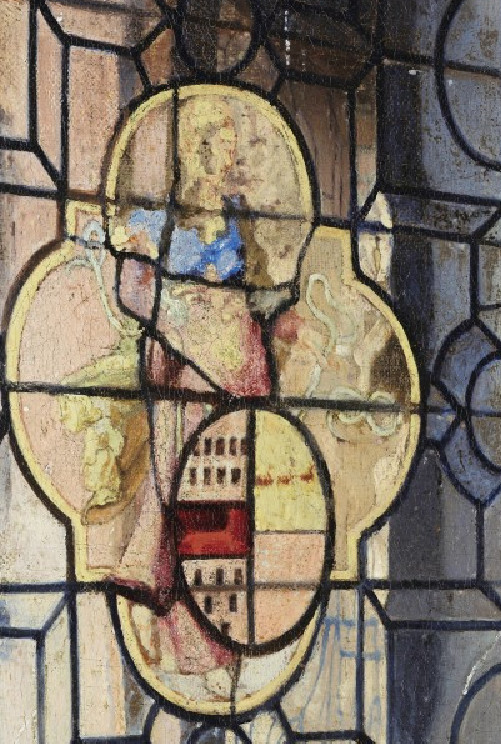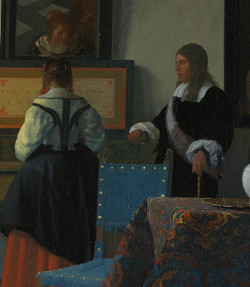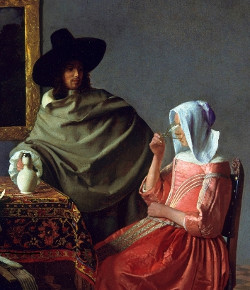The Glass of Wine
c. 1658–1660Oil on canvas
65 x 77 cm. (25 5/8 x 30 1/4 in.)
Staatliche Museen Preußischer Kulturbesitz,
Gemäldegalerie, Berlin
In about 1658–1659 Vermeer turned to the type of composition that had been adopted somewhat earlier by De Hooch, for example in The Visit (fig. 2) of about 1657 and in A Woman Drinking with Two Men and a Serving Woman of about 1658. In addition to The Glass of Wine, which probably dates from about 1658–1659, the paintings known as Young Woman with a Wineglass and Young Woman Interrupted at Music, both of about 1659–1660, represent interiors in which figures and furniture occupy the middle ground of a deep space that is mainly defined by the recession of floor tiles, a wall and window (or windows) to the left, and a wall in the background. As in Delft church interiors of the 1650s, linear perspective plays a conspicuous part in the composition, which, however, also suggests a natural flow of space beyond the limits of view, and a convincing sense of atmosphere through consistent gradations of color and light.

Johannes Vermeer
c. 1658–1661
Oil on canvas, 65 x 77 cm.
Staatliche Museen Preußischer Kulturbesitz,
Gemäldegalerie, Berlin
No analysis of artistic conventions can suggest the sheer beauty and extraordinary refinement of a painting like The Glass of Wine, which may be considered one of Vermeer's first fully mature works. Despite the parallel with De Hooch's designs and less obvious similarities with pictures by other artists, especially Gerrit ter Borch, this canvas and the Vermeer's of about 1659–1660 cited above no longer convey the impression (as does, for example, Cavalier and Young Woman of about 1657) of depending upon two or three principal sources. Here the artist has clearly mastered a visual language, which despite slips in syntax (as in the recession of floor tiles on the right) is employed with remarkable facility and grace. Vermeer was about twenty-seven years old when he painted this picture, and had reason to feel that his work had begun to rival that of Ter Borch or Frans van Mieris in quality and, at least in his own city, recognition.
The present work was first recorded in the 1736 sale of Jan van Loon's collection in Delft. Young Woman Interrupted at Music cannot be traced before 1810, but Young Woman with a Wineglass, a work reminiscent of Van Mieris's in aspects of its style and especially in expression, is probably the "merry company in a room" listed in the Dissius sale of 1696 (and later more fully described), that is, a picture first acquired by Vermeer's most important patron from about 1657 onward, Pieter van Ruijven. Thus the idea, first raised in connection with A Maid Asleep and The Milkmaid, that Van Ruijven at least encouraged Vermeer's interest in fashionable subjects also seems appropriate to the scenes of modern manners dating from about 1658 onward.

Pieter de Hooch
c. 1657
Oil on wood, 67.9 x 58.4 cm.
Metropolitan Museum of Art, New York

Johannes Vermeer
c. 1662–1665
Oil on canvas, 73.3 x 64.5 cm.
The Royal Collection, The Windsor Castle

Johannes Vermeer
c. 1658–1661
Oil on canvas, 65 x 77 cm.
Staatliche Museen Preußischer Kulturbesitz,
Gemäldegalerie, Berlin
Van Ruijven evidently owned The Music Lesson (fig. 3) as well. The man's close proximity to the woman in that picture suggests a tension similar to that of the couple in the present painting, although its precise nature is not the same. The comparison reveals how closely Vermeer considered postures and gestures, the subtleties of which he must have admired in works by Ter Borch. The man (fig. 4) in the Glass of Wine, unlike his counterpart in The Music Lesson, is cast in a dominant, not a captive, role; the woman's position seems very much subordinate to his own (compare Christ and Mary). The folds of the green cloak, one of Vermeer's most impressive passages of drapery, seem to trace the recent motion of the jug of wine. Confidence can be sensed in the carriage of the man's head and shoulders (which are covered, as if he had just arrived) and in his grip on the jug. The placement of that portentous motif within the composition seems perfectly natural and at the same time calculated to a degree; the framing of the jug within the linen nimbus of the man's cuff amplifies its significance.
The woman's pose is restrained and angular, as if her sip of wine fills an awkward pause in the conversation. A chair in the foreground, supporting a cittern, suggests the suitor's advance from another flank. The figure in the stained-glass window (fig. 1) holds a bridle forward like a bit of advice. She is Temperance, swathed in a cascade of drapery like the allegorical figures on William the Silent's tomb. The same window occurs in Young Woman with a Wineglass, where its placement and stronger colors establish a comparison with the inexperienced wine taster. Vermeer painted several variations on the theme of temperance, or moderation, from The Glass of Wine onward, perhaps the most inventive being the Woman with a Balance.

Elise Goodman
"The Landscapes on the Wall in Vermeer"The Cambridge Companion to Vermeer (Cambridge Companions to the History of Art)
2001, pp. 75–76
The pictures on Vermeer's walls emphasize the amorous themes of the paintings themselves and their varying mood and tone. In the relatively early The Glass of Wine, the relationship appears fairly simple and the touch light.
The wooded landscape in the style of Allart van Everdingen (1621–1675), which hangs conspicuously on the wall behind and to the left of the couple in the room, is emblematic of their amorous connection, which is suggested with delicacy and subtlety. In the painting itself, the elegant cavalier's gallant intention is alluded to by his intense gaze at the lady, for whom he is about to pour another glass of wine.

F. van Goor
Engraving
A preceding music making, presumably for the purpose of wooing, is hinted at by the songbooks on the table and by the cittern on the chair, which we may assume to have been used by the gentleman to serenade the young woman. He may be thought to have intoned a love song, perhaps like one of Hooft's (fig. 5), whose lyrics in the tradition of Petrarch and De Ronsard were often set to musical accompaniment. Some of these lyrics appeared in Hooft's noted Emblemata Amatoria (Emblems of Love), which has been drawn upon for interpreting the symbolism of Dutch genre paintings by other scholars. To our purpose, Hooft warbles seductively:
But one should ask what the singing means,
This wistful tune that charms:
It aims by these fanciful strains
To lure into mine arms
That one whose gentle waxen hands can mould
My hot and melting heart, which they enfold.
In The Glass of Wine all the orthogonals in Vermeer's linear perspective system significantly converge in the area of the landscape on the wall. It reinforces the delicate scene of the amorous proposition in the painting itself quite in the manner of many seventeenth-century literary landscapes. If it is exceptionally dark, it is perhaps because Vermeer wished to allude to the privacy of love. "Love's shadows are so rich in joy," as Shakespeare has it. But not only joy. Landscapes in literature could be settings for innocent amorous dalliance as well as physical delights. In contemporaneous love poems, such as Joost van den Vondel's "Koridon" (1665), a swain persuades his lady to seize the moment and accompany him to the forest, where he may kiss her mouth, cheeks, and ear with fond desire: "Through love will grow / The tree and bushes." A similarly seductive carpe diem melody is entoned in an air de cour -a lyrical melody whose major subject was love—for voice and lute accompaniment in Het luitboek van Thysius (The Lute Book of Thysius), published in Amsterdam in 1620. An eager lover here bids his belle to go to the "sacred shades" and recline on the grass while their young spring lasts. Likewise, but more explicitly, Hooft exhorts his Rosemund to join the carnival of nature, which "is straightway roused to full-blooded love-making." We may well imagine Vermeer's cavalier, already dressed in his cape and hat, to be intent on departing to a grove that will shelter his amour. But the darkness of the landscape behind him may well be a danger signal for his beloved; the carpe diem may become a carpe florem. That Vermeer intended at least lightly to caution the pair against immoderate behavior is indicated by the coat of arms on the partiality opened window at the left. It is primarily an indication of the high status of the elegant couple in the room, but it also contains a vague figure of a woman with a bridle in her hand, apparently the figure of Temperance, an emblem of moderation and a warning signal against excess. The short diagonal of the window containing the personification of Temperantia leads directly back to the enframed painting with its lush, seductive scenery, suggesting the need to react moderately to the call of nature's delights, no matter how beguiling.
The elegance of that setting [of Girl with Glass of Wine] is underlined in The Glass of Wine not only by the stained-glass window with the family crest, but also by the Persian carpet on the table and the painting in the gilded frame on the wall. As early as the seventeenth century, it became customary in the Netherlands to drape such a costly imported carpet over a table rather than put it on the floor. The painting-within-a-painting on masculine bravura. Might the woman, dressed in brilliant red satin, have set aside her cittern and music books when the man came in?

c. 1658–1660
Oil on canvas
65 x 77 cm.
Staatliche Museen Preußischer Kulturbesitz,
Gemäldegalerie, Berlin

Gerrit ter Borch
1658–1659
Oil on canvas, 41.5 × 32 cm.
London, Royal Collection Trust
An open music book hangs halfway off the table and the stringed instrument rests against the back of the Spanish chair with lions'-head finials in the foreground (fig. 6). On the seat is an open, oblong booklet with its spine facing up. The volume’s narrow format resembles that of the popular songbooks in the seventeenth century. Was she practising in anticipation of her admirer's arrival so as to play and sing with him? The man has an air of impatience, as if eager for her to drink up. The association with the classic ploy of seducing young women with alcohol is quickly made. However, that point has not yet been reached. The woman with the wine glass raised to her lips looks rather demure: her face is largely hidden by the white headscarf and her free arm is wrapped protectively around her waist. In depicting his elegantly dressed figures, Vermeer drew inspiration from the innovative work of his older colleague Gerard ter Borch, who had specialized in this type of refined genre scene from 1650 onwards. For example, Ter Borch’s A Gentleman Pressing a Lady to Drink (fig. 7) in the British Royal Collection features a similar interaction between a woman with a wine glass to her lips and a man—his hand on the neck of a jug—intently watching her. While Ter Borch shows little of the interior, for Vermeer the domestic environment is an essential part of the composition.

